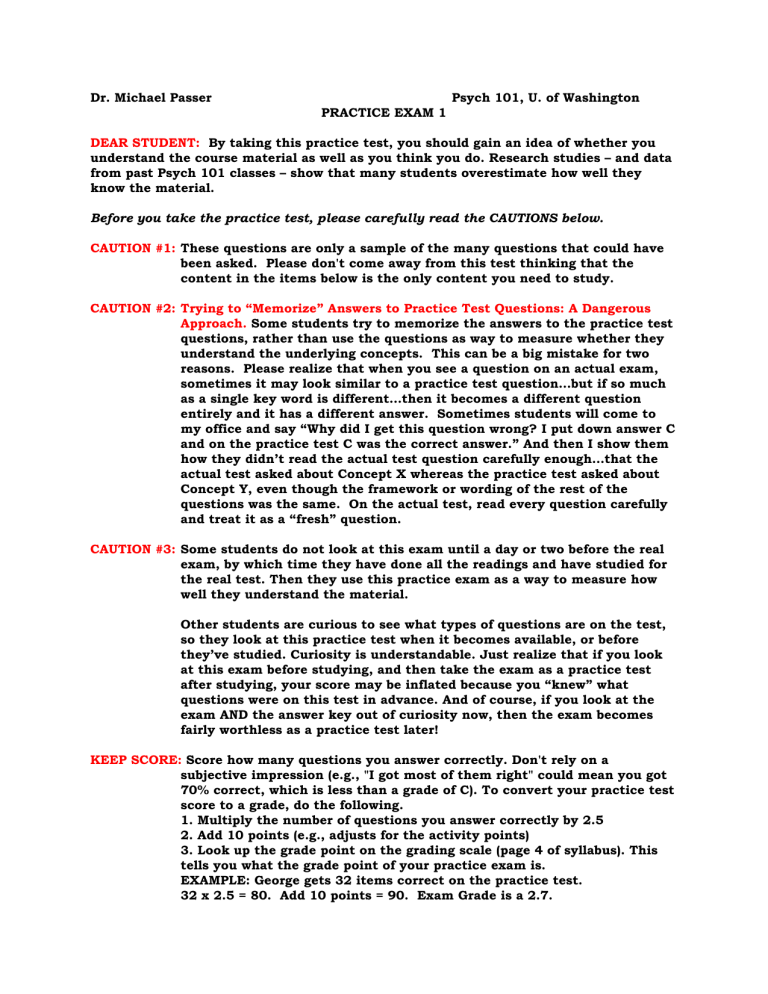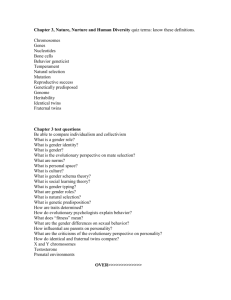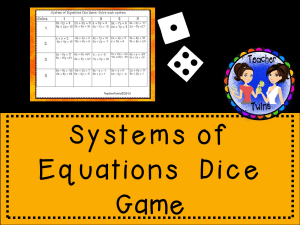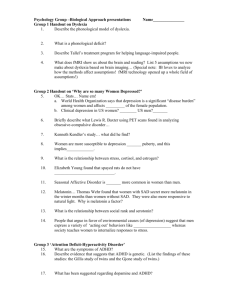
Dr. Michael Passer Psych 101, U. of Washington PRACTICE EXAM 1 DEAR STUDENT: By taking this practice test, you should gain an idea of whether you understand the course material as well as you think you do. Research studies – and data from past Psych 101 classes – show that many students overestimate how well they know the material. Before you take the practice test, please carefully read the CAUTIONS below. CAUTION #1: These questions are only a sample of the many questions that could have been asked. Please don't come away from this test thinking that the content in the items below is the only content you need to study. CAUTION #2: Trying to “Memorize” Answers to Practice Test Questions: A Dangerous Approach. Some students try to memorize the answers to the practice test questions, rather than use the questions as way to measure whether they understand the underlying concepts. This can be a big mistake for two reasons. Please realize that when you see a question on an actual exam, sometimes it may look similar to a practice test question…but if so much as a single key word is different…then it becomes a different question entirely and it has a different answer. Sometimes students will come to my office and say “Why did I get this question wrong? I put down answer C and on the practice test C was the correct answer.” And then I show them how they didn’t read the actual test question carefully enough…that the actual test asked about Concept X whereas the practice test asked about Concept Y, even though the framework or wording of the rest of the questions was the same. On the actual test, read every question carefully and treat it as a “fresh” question. CAUTION #3: Some students do not look at this exam until a day or two before the real exam, by which time they have done all the readings and have studied for the real test. Then they use this practice exam as a way to measure how well they understand the material. Other students are curious to see what types of questions are on the test, so they look at this practice test when it becomes available, or before they’ve studied. Curiosity is understandable. Just realize that if you look at this exam before studying, and then take the exam as a practice test after studying, your score may be inflated because you “knew” what questions were on this test in advance. And of course, if you look at the exam AND the answer key out of curiosity now, then the exam becomes fairly worthless as a practice test later! KEEP SCORE: Score how many questions you answer correctly. Don't rely on a subjective impression (e.g., "I got most of them right" could mean you got 70% correct, which is less than a grade of C). To convert your practice test score to a grade, do the following. 1. Multiply the number of questions you answer correctly by 2.5 2. Add 10 points (e.g., adjusts for the activity points) 3. Look up the grade point on the grading scale (page 4 of syllabus). This tells you what the grade point of your practice exam is. EXAMPLE: George gets 32 items correct on the practice test. 32 x 2.5 = 80. Add 10 points = 90. Exam Grade is a 2.7. Page 2 Directions: This exam contains 40 questions. Choose the best single answer for each question. Be sure to answer all questions. Be sure to "bubble in" your name, ID#, and Version of the Exam on your mark sense form. 1. A central idea or assumption of “monism” is that: a. the mind is a spiritual entity that does not follow physical laws. b. the mind and the body(brain) are one, and thus mental events are a product of physical events. c. when you break down a single, complex behavior into two or more simpler behaviors, you lose the essence of that complex behavior. d. the body and the mind are separate, although they may interact with one another. 2. Juan is walking in the U-District and starts to cross the street, even though the light is red. He doesn’t look carefully and fails to see the car coming toward him. The car swerves at the last second and misses hitting Juan by two feet. A very close call. Juan is startled and freezes in position. Instantly, his heart rate increases, he breathes very rapidly, and he starts to perspire. Which part of Juan’s nervous system has directly produced this increase in Juan’s arousal level? (Note: There are only 3 choices below.) a. the somatic nervous system b. the parasympathetic nervous system c. the sympathetic nervous system 3. In a correlational study examining two variables, X and Y, the researcher would ________ variable X and __________ variable Y. a. manipulate; measure b. manipulate; manipulate c. measure; manipulate d. measure; measure 4. As your eyes focus on an object that is close to you, muscles turn your eyes toward each other. The muscle movement provides information that the brain uses to help judge how far away the object is. This depth/distance cue is called: a. linear perspective. b. interposition. c. convergence. d. binocular disparity Page 3 5. Rachel's brother recently died from cancer. Since then, Rachel has felt completely "lost" and confused. She spends a lot of time wondering about the ultimate meaning of life, and she is perplexed about what direction she should take (e.g., in choosing a major) in order to maximize her potential for personal growth. In general, a psychotherapist or counselor who has a _____________ orientation would be MOST likely to focus on Rachel's confusion over personal growth and the ultimate meaning of life? a. cognitive b. Freudian psychoanalytic c. behavioral d. humanistic 6. Neuron A sends excitatory input to neuron B. This excitatory input will cause the electrical charge inside neuron B to become ______________ relative to the charge outside. If this change in the neuron’s electrical charge is sufficient to reach the ________________ then this particular neuron will “fire” (i.e., a nerve impulse will be triggered). a. less negative; actional potential threshold b. less negative; refractory point c. more negative; actional potential threshold d. more negative; refractory point 7. In survey research, ____________ is used to select a group of participants that is representative of the overall population. a. a placebo procedure b. counterbalancing c. random assignment d. random sampling 8. Rowena and Charles are sitting in a room. Suddenly Charles says, "Wow, did you feel that? The building was shaking for a moment. I think we just had an earthquake!" Rowena replies, "Really? I didn't feel a thing." Therefore, it appears that Rowena and Charles have a different __________ for detecting this type of sensory stimulation (e.g., movement or swaying). a. absolute threshold b. difference threshold c. sensory adaptation point d. Weber's law coefficient 9. _____________ is a neurotransmitter that plays an especially important role in regulating functions such as sleep, appetite, and mood. Abnormal levels of this neurotransmitter have been linked to certain types of depression. a. Glutamate b. Dopamine c. Serotonin d. Acetylcholine (Ach) Page 4 10. Shih-Fen is a split-brain patient (you can assume she is right-handed). She looks directly ahead at a small screen. Simultaneously and for just a fraction of a second the word AIR is flashed on the left side of the screen and the word PLANE is flashed on the right side. (See the diagram below; the center line is the middle of the visual field). When Shih-Fen is asked to verbally report the word she she saw, she will most likely say: AIR a. b. c. d. PLANE "I didn't see any word." "AIR." "PLANE." "AIRPLANE." 11. Dr. Kapoor conducts a study in which she asks 500 students in an Introductory Psychology class to answer the following question: “Compared to the other students in this class, how well do you get along with other people?” Students rate their ability on a scale ranging from -3 (Well below average) to +3 (Well above average). Dr. Kapoor finds that 90% of the students rate their ability as “above average” (i.e., either +1, +2, or +3). Based only on the information given above, which of the following goals of psychology is most clearly illustrated by Dr. Kapoor’s study? a. description b. explanation c. prediction d. control e. application 12. Twin studies and adoption studies are commonly conducted by researchers in the field of ___________ . As discussed in the text, studies of twins raised togther and of twins raised apart have found that, for many basic personality traits such as extraversion (sociability) and neuroticism (anxiousness): a. behavior genetics: fraternal twins raised together are just as similar as identical twins raised apart. b. behavior genetics: identical twins raised apart are more similar than fraternal twins raised together. c. genetic engineering: fraternal twins raised together are just as similar as identical twins raised apart d. genetic engineering: identical twins raised apart are more similar than fraternal twins raised together. 13. The most basic principle illustrated by the phenomenon of "perceptual set" (i.e., "mental set") is that: a. most of our fundamental perceptual abilities are present at birth. b. our expectations influence our perceptions. c. cross-cultural similarities in perception occur because perception is determined by the brain, and humans share the same basic brain structure. d. after we are exposed to a stimulus for a period of time, our senses adapt to it and we no longer perceive it. Page 5 14. Thelma is participating in a scientific study of the brain. The researchers are taking a series of narrow-beam x-rays of her brain from different angles, and these x-rays will then be converted into in an image that shows part of the interior structure of Thelma's brain. In this example, the researchers are using _______________ to examine Thelma's brain. a. an EEG (electroencephalograph) b. a PET scan (positron emission tomography) c. an MRI (magnetic resonance imaging) d. a CT (CAT) scan (computerized axial tomography) 15. Dr. Fushikoshi conducts an experiment. Each participant is placed in a room and performs a physical task. For half of the participants the room is kept quiet while they do the task. For the remaining participants, background music is broadcast into the room while they do the task. Dr. Fushikoshi records the quality of each person’s task performance. In this experiment the fact that each participant is placed either in a quiet room or a room with background music represents: a. the dependent variable. b. the independent variable. c. a confounding variable. d. a demand characteristic. 16. Suppose that Dr. Fushikoshi (see question above) finds that women who work in the room with music perform more poorly than women who work in the quiet room. Because Dr. Fushikoshi’s study was carefully controlled, there are no plausible alternative explanations for the results (i.e., there are no confounding variables). The absence of alternative explanations directly means that Dr. Fushikoshi's experiment has: a. poor external validity. b. good external validity. c. poor internal validity. d. good internal validity. 17. Continuing our discussion of Dr. Fushikoshi’s experiment (Question #15 above), suppose that several other studies have been conducted -- both in laboratory and "real-life" settings -- and these studies have found results similar to those of Dr. Fushikoshi's experiment. This tells us that Dr. Fushikoshi's results appear to have __________ . a. poor external validity. b. good external validity. c. poor internal validity. d. good internal validity. Page 6 18. You run across a friend, Arnold, at the University Book Store. He is thinking of spending $20 for an audio tape that plays relaxing music and contains special subliminal messages designed to enhance one's self-esteem. Knowing that you are taking Psych 101, Arnold asks you for your advice about whether this type of subliminal persuasion is effective. Based on the research evidence, what should you tell him? a. "Yes, buy the tape. The subliminal content of the tape will help you increase your self-esteem because it "sneaks in" beneath you conscious defenses." b. "Yes, buy the tape. It can help you increase your self-esteem, but nobody really knows why it works." c. "Don't buy the tape. Our sensory systems are not able to detect subliminal stimuli and therefore these stimuli cannot possibly influence any type of behavior or judgment." d. "Don't get the tape. Our sensory systems detect subliminal stimuli, but the stimuli are too weak to influence self-esteem. If your self-esteem changes, it'll just be a placebo effect. 19. The axon terminals of a neuron are specialized for: a. regulating the life functions of the neuron. b. storing neurotransmitters and releasing them into the synaptic gap. c. providing a sheath that covers the axon and increases the speed of a nerve impulse. d. receiving messages from other neurons. 20. Leonard Nimoy is a famous television actor who played the character "Mr. Spock" in the original TV series "Star Trek." In case you are not familiar with this TV series, Mr. Spock was a highly intelligent alien who lived his life according to principles of "logic" and tried to suppress or avoid emotions . Leonard Nimoy has stated that his fans typically expect him to be just like Mr. Spock: logical and showing no emotion. In other words, his fans seem to ignore the fact that Nimoy was just an actor playing a role, and therefore Nimoy's behavior was being determined by the situation, not by Nimoy's own personality. Thus, Nimoy's fans are: a. demonstrating the "we're all better than average" bias. b. displaying synesthesia. c. committing the fundamental attribution error. d. displaying a lack of perceptual constancy. e. displaying a lack of perceptual closure. 21. Alexander is 20 years old and has been blind since birth. Now, a newly developed surgical procedure allows him to see for the first time. Based on studies of similar cases in the past, we should expect that after a minute or so in which his eyes adjust to the light, Alexander: (Note: There are only 3 choices below.) a. will immediately have near-normal vision perception (e.g., good perceptual constancy; able to visually identify objects that he used to identify by touch). b. will immediately display only a few basic visual-perceptual abilities (e.g., able to scan and follow moving objects) c. will have absolutely no visual-perceptual abilities at first. Page 7 22. Dr. Kiel is designing a study to test the effectiveness of a new antidepressant drug. In her study, every participant will receive a pill each day, but will not be told whether that pill actually contains any of the drug. In addition, the researchers who come into contact with the participants, and who record any changes in the participants' level of depression, will not be told which participants actually received the drug. This type of research design is called the _______________ . a. simple placebo-group procedure b. expectancy control procedure c. demand characteristic suppressor d. double-blind procedure. 23. Elissa recently went horseback riding and, unfortunately, had a bad fall. She was kicked by the horse, causing some brain damage. Elissa has no trouble speaking, but as a result of this damage her speech comprehension is impaired; she now has difficulty understanding what other people are saying when they speak. This indicates that Elissa most likely suffered damage to her: a. Wernicke’s area. b. Broca’s area. c. thalamus. d. reticular formation. 24. For most people, according to principles of performance enhancement that were discussed in your text, which of the following statements represents a good strategy for taking multiple-choice tests? a. Answer all questions in order. Do not skip over some questions and try to come back and answer them later. b. If you don't know the answer, then always choose alternative "b" because it most often is the correct answer. c. If you begin to feel uncertain about an answer that you've already chosen, don't change it. Most people typically end up changing a correct answer to an incorrect answer. d. After reading a question, try to answer it before looking up the choices. 25. The process by which the brain interprets and gives meaning to incoming sensory information is called: a. transduction. b. lateralization. c. sensation. d. perception. 26. Paul is left-handed and Jay is right-handed. Therefore it is most likely that: a. Both Paul and Jay’s language functions are primarily lateralized in the right cerebral hemisphere. b. Both Paul and Jay’s language functions are primarily lateralized in the left cerebral hemisphere. c. Paul’s language functions are primarily lateralized in his right-hemisphere, and Jay’s language functions are primarily lateralized in his left hemisphere. d. Paul’s language functions are primarily lateralized in his left-hemisphere, and Jay’s language functions are primarily lateralized in his right hemisphere. Page 8 27. Robin is a “behaviorist” and strongly believes in the behavioral perspective. Therefore, when Robin is asked to explain why people are aggressive or violent, she would most likely say that aggression is caused by: a. reinforcing stimuli in the environment. b. genetic factors. c. unconscious hostile urges or feelings. d. the individual’s personality traits. e. the individual’s attitudes about aggression. 28. If two variables, A and B, are correlated, then you: a. can conclude that variable A causes variable B . b. can use the scores on variable A to estimate (i.e. try to predict) the scores on variable B. c. can do both of the above. d. cannot do any of the above. 29. If two variables are perfectly correlated, then when you look at their scatterplot, the various data points will: a. form a single dot. b. form a straight line with half of the dots falling above the line and half of the dots falling below the line. c. form a straight line with all the dots falling directly on that line. d. form a perfect circle. 30. Dr. Adams is a psychologist who observes and simply records the mating habits, eating rituals, and aggressive and cooperative interactions of chimpanzees in their natural habitat. In conducting this research, Dr. Adams only goal is to increase our scientific understanding and knowledge of chimpanzee social behavior. Thus, her research is best classified as an example of: a. basic research that uses a descriptive or correlational approach. b. basic research that uses an experimental approach. c. applied research that uses a descriptive or correlational approach. d. applied research that uses an experimental approach. 31. Sharon has hydrocephalus, which means that: a. the ventricles in her brain have shrunk and thus are abnormally small. b. the ventricles in her brain have expanded and thus are abnormally large. c. she was born without any ventricles in her brain. d. she was born with a normal left hemisphere, but the entire right hemisphere of her brain is missing. 32. Integrating the viewpoints of psychology’s six major historical perspectives, modern psychological science examines behavior from three general “levels of analysis.” As described in your textbook, these three levels of analysis are the ______________ levels. a. psychological, philosophical, and environmental b. psychological, philosophical, and empirical c. biological, psychological, and environmental d. biological, psychological, and philosophical Page 9 33. Greg has consumed a lot alcohol at a party, which has depressed (i.e., dampened down) the activity of his nervous system. In fact, his neural activity is so depressed that he is about to pass out. This response primarily occurs because alcohol: a. increases the activity of GABA. b. decreases the activity of GABA. c. increases the activity of acetylcholine. d. decreases the activity of acetylcholine. 34. This is a question about your Syllabus (which was one of your assigned readings). There are 3 exams in this course, including the final. Which of the following statements about these exams and the grading system for this course is true? a. You can drop your lowest exam, and it will not count at all toward your grade. b. Your lowest exam score will be “discounted” by 50% and count only half as much as each of your higher scoring exams. c. Each of the three exams will count equally toward your final course grade. d. The third exam (the final) is “cumulative,” and will cover the material from the entire course. 35. The ___________ is a brain structure that is part of the limbic system and plays an important role in fear and aggression. For example, if you electrically stimulate certain areas of this brain structure in a cat, you will produce an immediate aggressive response. a. thalamus b. cerebellum c. hippocampus d. amygdala e. reticular formation 36. Suppose that Dr. Lopez conducts a study and finds a positive correlation between people’s annual income and their level of creativity (as measured by a psychological test). This tells us that: (NOTE: There are only 3 choices below.) a. people with higher income levels tend to be more creative. b. people with higher income levels tend to be less creative. c. there is no association between people’s level of income and how creative they are. 37. Historically, psychology’s first intellectual school of thought was called ______________ , and researchers who belonged to this “school” of thought used the method of introspection to study the nature of the mind. a. psychoanalysis b. behaviorism c. functionalism d. structuralism 38. Jason has brown eyes. This describes Jason’s: a. phenotype b. genotype c. genetic makeup d. heritability coefficient Page 10 39. Antoine has applied for an engineering job at the KRO Consulting Firm. He is excited by the fact that, in the company’s job recruiting brochure, it says that the average salary of the 10 “beginning” engineers (who have been with KRO for one or two years) is $55,000 year. However, as we discussed in class, because ____________ is/are distorted by extreme scores, it would be important for Antoine to ask KRO for more detailed information about the starting salary for the job. (NOTE: There are only 3 choices below.) a. the statistical mean b. the statistical median c. both the mean and the median 40. Lavonne has a rare disorder. When she tastes something sour, she literally “sees” the color blue. When she tastes something sweet, her visual system “sees” the color red. Likewise, when she tastes other flavors, her visual system “sees” various colors. This mixing-up of the senses is the only symptom of her disorder. This disorder is called: a. aphasia. b. schizophrenia. c. synesthesia. d. the Ponzo illusion. e. a domain-specific mechanism disorder





